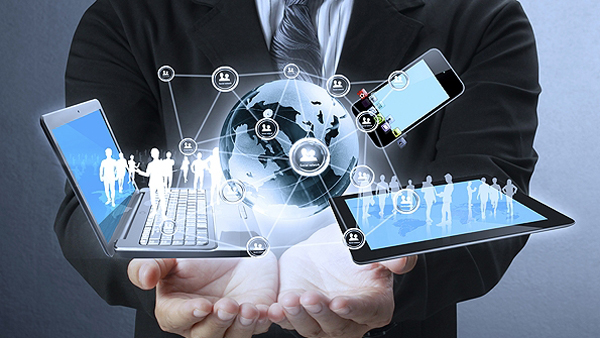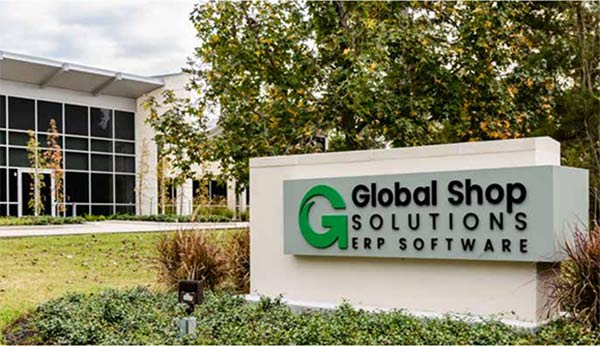Yesterday´s Future is Today´s Reality – why running SaaS ERP is a game changer in the Industry. In the area of Business applications, cloud seems to be all over the place. But it has many facets which all have its right to exist, though it´s a fatal misunderstanding to see cloud simply as an alternative technical deployment option.

From the new millennium SaaS models that have been adopted, initially with huge appetite in dedicated Line of Business areas. We would call them Cloud 1.0 solutions, mainly CRM, HCM, SRM, Travel Management. The hunger for faster innovation cycle and independence of corporate IT was huge and drove cloud to new heights. But moving into the cloud was not about a technological movement alone.
We would like explain via Customer Relationship Management: For CRM it was a fundamental mind shift towards tools supporting “The Salesman of the 21st century”, a highly social, collaborative and cross-linked persona who is able to manage customer relations in the most comprehensive and collaborative way. Sales Force Automation was legacy before that inflection point and Innovations often left this highly critical group outside as it was focused on the back end, often COO-lead processes to control sales and operations. A sales rep simply wasn´t in focus and so not able to win the battle for the customer by ignoring new possibilities.
Now, as this LoB markets have been settled in favor of SaaS, we again see the world changing in time-lapse. In a fully digitized world, information can be measured and made available across the globe instantaneously. Sailing on the back-wind of new technologies, this is a key enabler for companies to rethink their market position and strategy – and redefining business processes. Fundamentally, it means that a digital business need to deliver on the ubiquitous promise to truly serve a segment of one: The end consumer. The whole value chain becomes a highly flexible organism to be run in real time – it becomes a LIVE Business.
At the same time became the definition of ERP volatile in the market space. From post-modern ERP definitions that stopped beyond core HR and Finance to an ERP definition, which is now maturing and looking at a federated suite transforming into a digitized core-to-edge definition. When customers consider moving their ERP to a SaaS solution, it is driven by the need to get far beyond a new deployment option. Cloud adoption is not a technological decision, it is transformation to re-invent core ERP applications like accounting and finance, procurement, manage stocks, production and materials management, R&D – serving the needs of the digital economy.
As a result it enables enterprises running more flexible and foster innovations faster – this is the corporate imperative today. SaaS customers always run on the latest innovation and clients can focus on core business rather than keeping track with upgrades – after all, it´s software as a service.
A Short History of ERP and SaaS ERP
Since the 80s, companies like SAP have successfully shaped and anticipated market trends and helped countless businesses run better. As new mega-trends emerged or were inspired by SAP, like ERP itself, we restlessly drove the industry to solve the next decade’s needs. The achievements created during one megatrend became the status quo for the next, providing the building blocks to a new and even more innovative way of tackling the next generation´s problems, meeting new demands, and driving businesses to work increasingly in real-time.
ERP systems focused originally on automating back office functions. In the year 2000 ERP was coined the first time dead in an article. And re-invented within the same article again. Gartner described web-based software that provides real-time access to ERP systems to employees and partners including suppliers and customers. The new ERP expands traditional ERP resource optimization and transaction processing. Rather than just document the physical reality it became a connected platform to interact between Enterprises.
Later ERP was coined dead again many times (and for sure will be coined many times to come mostly by cloud 1.0 vendors that have no alternative), though the undisputed success of the business suite speaks for itself. Just look at the growth rates or talk to the leaders in companies that need to digitally transform. They know they need a new core – just innovate at the edges does not deliver the value they need. Additionally enterprises want to and can leverage on premise investments while growing into the next inflection point in global business. At the same time, business changed at an unprecedented pace.
Mid of last century, most companies could expect to last forever. In today’s fast changing world, companies are chased by disrupted everywhere. A shrinking life expectancy of companies on the Fortune 500 index from 75 years to 15 years as reported by Steven Denning (Forbes) and the fact, that 4 “Start Ups” (Facebook, Uber, Airbnb, Alibaba.com) today equals 60% of the market cap of the German stock market DAX speaks a straight language: Fast Innovators – hungry for success – disrupt established markets.
Not necessarily fueled with better products but better customer service strategies – focusing even on the customers of their customers (B2B2C). Smart companies leapfrog industry borders and sell additional products and services into existing markets and leave established market leaders perplexed behind. We recognized many Blue Chips has fallen flat and became irrelevant in one single decade.
Modern ERP need to support this fast and dramatic shift without losing its capabilities to run like a clockwork.
The Demand for an Intelligent Enterprise
Charles Duell said in 1899 – “Everything that can be invented has been invented”. No doubt, all established companies were truly entrepreneurs with tremendous achievements in their respective markets. They have each performed outstanding upon entering the market and they all had great advantages over the competition … for the time being.
A new dilemma arises once companies become market leaders: to maintain their hard-won position, they now put themselves on the defensive. The most innovative companies start becoming conservative the moment they become successful. True, this helps their business position. Unfortunately, this also potentially signals the beginning of the end of their innovation leadership.
For too many companies Digital Transformation is an excuse to focus on yester-years growth rates, at the end loosing against others because they do not challenge themselves early and often enough.
The digital economy it about the End-to-end experience. You don´t book an UBER because they run better cars. You book an Uber because you can start your journey wherever you are. At your fingertips on your smartphone. Easy to use, once you are registered, the same experience everywhere for global travelers. And you know what you get. You can visualize your position against the next free ride, what car, how does the driver look like, no local cash required, invoices via email for your expense report, fair prices as all is tracked via GPS.
The new technical possibilities and customer behavior makes the digital storefront a MUST have to compete and ultimately survive in the digital economy. Companies want to be where the customers are. It is a logical consequence of the Segment of ONE. Customers want to be treated as individuals, not in a segments with others any more.
But what´s next after digitizing my storefront? It creates a huge new promise to the market.
“Dear Mr Customer, I am a service (oriented) company and I will treat you exceptional well”.
This triggers an average invoice value decrease while the number of invoices is exploding – first of all no problem for a mature enterprise solution that thinks and acts end-to-end. Though similar impact you will have in your enterprise logistics, the average value and size of lots is going down while the number of lots is going significantly up. The direct consequence of this “UNIT of ONE driven order size” seeps throughout the entire organization. How can I keep my corporate functions working at scale in such an environment?
Also, think of adopting Big Data. How long have we been talking about Big Data in the Industry? Here is our question to you: How much has changed in the individual workplace of your employees since this term is socialized? How many better decisions have your employees made, because of smart insights? The standard answer we get, well….
At the end we would argue that Big Data is not the problem, the focus needs to be the “right” Data, leveraged in context of the adequate business process and brought to the attention of an end-user exactly at the moment he makes his business decisions.
The ability to ride through this digital storm requires adopting new perspectives and technologies.
To address this, customers need to automate repetitive tasks and decisions based on information available. It is time to rethink the core processes. With the combination of machine learning and predictive analytic´s, we are going to enter the decade of Intelligent Enterprise, automating standard business functions, and leaving room for differentiating activities to the individuals. It is about exception based handling and not filling the workdays with routine tasks any more.
Now, what defines a digitized core?
1. An architecture that delivers a scalable foundation to transact at highest possible automation
2. A system of intelligence that supports and steers the business using embedded analytic´s, simulation, prediction, and decision support to run LIVE business
3. An end-to-end experience that allows to be faster implemented, consumed, and adapted- with best information at the time decisions are made
4. An open architecture to allow connected-ness and adoption of micro-services
Key drivers for customers to move to the cloud
Driven by the subscription economy, the distance between the engineer and the end user of a product has been dramatically reduced – even more: the industry entered into a service business model. The result is an unmatched speed of innovation, simplicity and reduced time to value. This hits the companies´ core value, their brands. The currency of the past was a superior product; todays currency is a superior end-to-end-experience of a product. Bying a product bonded customers for some time, the minimum span was the financial depreciation of the investment. A subscription economy is a highly volatile service business with different rules, focused on the essence of things and needs.
Moving a “companies´ Core” to the Cloud enables a fast deployment and improves time to value. Additionally, it fosters rapid innovation cycles and reduces TCO and TCI, matching a fit2standard and enabling agility in consumption. The end2end experience is at the heart of it, not the product on its own.
But for customers and partners there are new rules of the game to adapt and digitally transform as well. Technology induced innovation change the market demand fundamentally goes along with business changing capabilities for each Line of Business. Enterprise customers expect to re-define, innovate and digitize its core asset – ERP, and consume it as a SaaS model. The SaaS model is fast becoming a de-facto standard for deploying ERP across the market space. New digital advances have caused this tectonic shift in the enterprise technology as described above.
The latest wave of technology innovations was effectively leveraged by consumer driven companies, IT in the cloud was mainly deployed for the sake of a better customer service.
Enterprises are now catching up to digitize the core. By leveraging new technological innovations, it is now possible to eliminate many technical limitations in enterprise applications, a journey which nearly every company embarked on, the TOP expectations to be mentioned:
Fast time to value: Adoption of SaaS for Line of Business cloud solutions is already a commodity. Customers are now beginning to deploy core ERP in the cloud to regain velocity and adopt new technologies.
Shifting CapEx to OpEx also for Core ERP: Companies prefer to gain flexibility and grow the solution with the company in a flexible model without locking in capital. Especially a highly volatile market with mergers, de-mergers and divestitures driven by the digital transformation is in favor of highly flexible capital models.
Change to an Insight To Action driven model: Modern ERP systems are Systems of Intelligence”, not “Systems of Records” anymore. The transactional workload of an individual needs to be reduced to 10% exception based handling to keep the increasing volume of digitized companies manageable.
Fast(er) adoption of latest technological innovation: Faster adopt new technologies such as consumer-grade UX, IoT, Big Data adoption, machine learning, blockchain – to just mention a few – without long or additional implementation cycles. Simply consuming new innovation with the latest version every quarter.
Freeing up IT resources for strategic innovation topics and differentiating processes, like enabling the Enterprise for digital transformation and drive Innovations according to the Gartner Bimodal IT, while relying on the core to run like a clockwork in a federated environment.
Sven Denecken



